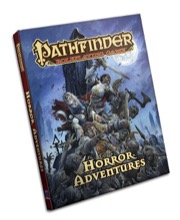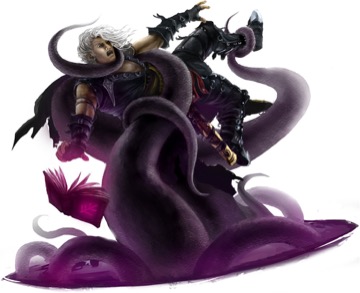Unleashing Horror Adventures
Thursday, July 21, 2016
At PaizoCon's "Horror in RPGs" seminars, in products like Pathfinder Campaign Setting: Rule of Fear, and pretty much wherever else I'm given the chance, I've talked quite a bit about how to run unsettling Pathfinder games(—you're all coming to our Horror in Pathfinder event at Gen Con, right?). In writing Chapter 6 of Pathfinder RPG: Horror Adventures, Running Horror Adventures (and in the book's section on "Playing Horror a Hero"), I've compiled some of my creepiest techniques and gaming philosophies, sharing them to help all you GMs out there make your Pathfinder games truly frightening.
But creating a truly unnerving game isn't as simple as choosing the scariest monsters and dreaming up spooky plots. To that end, the chapter starts by asking what you're trying to accomplish by running a horror game. A horror game is—obviously—meant to be "horrifying," but who are you as the GM trying to horrify? The characters or the players? And, in either case, are the players cool with that? The GM and players being of the same mind regarding the experience they're sharing is one of the most overlooked but most important parts of running a horror game, so we cover all that right up front.
Once we're certain everyone's in for horror, the chapter delves into a discussion of several popular horror genres—like cosmic horror, ghost stories, gothic horror, and others. Beyond just the themes and plots associated with these genres, each explores tools in the Pathfinder RPG that can help you affect these specific modes of terror. Want to know what monsters work best for slasher horror? No prob. Want some basic and advanced plots for running psychological horror games? I've got you covered. Not sure what a body horror game is? Oh boy, do I have some stories for you.
But even the best rules and plots are only stepping-stones to creating unsettling game experiences. Therefore, a meaty chunk of the chapter provides some of my favorite tips for steeping your game in an ambiance that lets fear flourish. These go beyond just tips for lighting and sound, providing simple and reasonable theatrics GMs can employ to keep their players engaged, as well as ways players can contribute to a sense of fear and mystery. Maybe even more useful, there's also a solid list of things NOT to try.
One of the most important elements of building a game's atmosphere, though, is to keep up the momentum. There's nothing creepy about interrupting the game to flip through rulebooks for 10 minutes. So, to help avoid that, the chapter's final section covers rules ad-libbing. These are things you can do to use the rules you know (or have on hand) to roll with whatever crazy scheme the players come up with. Beyond just telling you what every veteran GM already knows—that you can tinker with the rules as much as you want—this section gives you a step-by-step process on how to think like an ad-liber and how to kit-bash whatever rules you need on the fly. As a result, it walks you through how to run situations like being buried alive or burned at the stake using bits from the rules toolbox you already have.
Overall, the chapter is designed to be a guide to running horror games, but there are a ton of tools here to add to your bag of GMing tricks. Chapter 6 of Horror Adventures helps you learn what sort of story your players are up for, assists you in setting the stage, and then gives you techniques to make PCs dread what's to come. Those skills are handy for running a horror game, but, in my opinion, they're vital to any Pathfinder game you want to make truly memorable.
Pathfinder RPG: Horror Adventures debuts in just a few short weeks. Look for it here on paizo.com, your local game store, or at the Paizo booth at Gen Con!
F. Wesley Schneider
Editor-in-Chief
We have updated our Privacy Policy.
Paizo.com uses cookies. You can block paizo.com from using cookies within your browser settings, but doing so will hinder site functionality.
More information can be found in our Privacy Policy.


